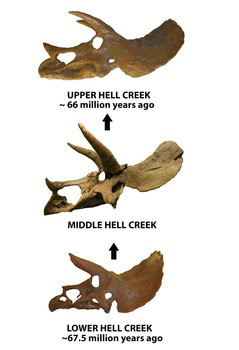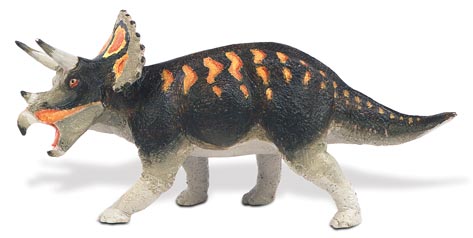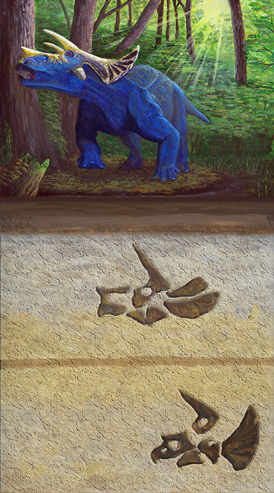Insights into the Evolution of Triceratops
It might sound like a Rudyard Kipling “Just So” story but scientists from Montana State University have been working out how Triceratops got its beak and horns. The team of researchers had spent the past fifteen summers mapping and excavating Triceratops skull material from the Badlands of eastern Montana, from the world famous Hell Creek Formation. University PhD candidate John Scannella and his three co-authors have published a paper in the “Proceedings of the National Academy of Sciences”, that reports on the study of more than fifty Triceratops specimens and plots how this dinosaur gradually changed over two million years.
The Location of Each Triceratops Fossil Recorded
The team recorded the precise stratigraphic location for each Triceratops fossil. The shape and characteristics of any skull material was then carefully analysed and this permitted the researchers to see evolutionary trends in the Triceratops genus through the Late Maastrichtian faunal stage.
The team noted that over one to two million years, the Triceratops skull specimens slowly changed. They went from having a small nose horn and a long beak to having a longer nose horn and a shorter beak.
The two recognised species of Triceratops can be distinguished from each other by the shape and size of the beak and the shape and size of the nose horn. Triceratops horridus has a small nose horn and a long beak, whereas, the second species in the genus Triceratops prorsus has a longer nose horn and a shorter beak. Triceratops horridus fossils were confined to the older strata, the lower portions of the Hell Creek Formation, whilst fossils of T. prorsus were found in younger rocks at the top of the Hell Creek Formation. Skulls found in the middle portions of the Formation displayed characteristics of both Triceratops species.
New Study Plots the Evolution of the Triceratops Genus
Picture credit: Montana State University
The picture above shows that at rock layers dated to around 67.5 million years ago, fossils of Triceratops horridus with its large beak and short nose horn can be found. In the Middle Hell Creek Formation, Triceratops skulls display a mix of T. horridus and T. prorsus traits. In the youngest, top sediment layers, it is the T. prorsus skull morphology that dominates.
Commenting on this research, student John Scannella stated:
“This study provides a detailed look at shifts in the morphology of a single dinosaur genus over time.”
Two Species Found at Different Horizons
The Triceratops research, identifying that specimens of T. horridus and T. prorsus are found at different horizons, specifically Triceratops prorsus is confined to the upper third portion of the Hell Creek Formation. The fact that these fossils are restricted to different stratigraphic levels confirms that there are indeed at least two species of Triceratops present.
A number of hypotheses had been proposed previously to help explain the different skull morphology, for example it had been suggested that the skull morphologies were a result of differences between males and females or due to ontogenetic (growth) variations between individuals of a single species.
The Triceratops Family Tree is Explained
Picture credit: Safari Ltd
Mapping the Fauna and Flora of Hell Creek
A number of academic institutions have been working together to map and record the flora and fauna preserved in the Hell Creek Formation. The Hell Creek project involved Montana State University, The University of California plus the universities of North Dakota and North Carolina with the support of a number of academic and professional bodies. The strata covers Montana, North and South Dakota and Wyoming in the Western United States and it represents a series of freshwater and brackish deposits laid down on the edge of the Western Interior Seaway. The geology records the very end of the Cretaceous with the very youngest rocks ascribed to the Danian faunal stage (Palaeocene) , the first faunal stage after the Cretaceous mass extinction event.
A Changing Ecosystem
The project examined both vertebrates, invertebrates and plants in a bid to learn about the changing ecosystems in that part of the world from the latter stages of the Cretaceous and into the Age of Mammals (Cenozoic). Over the course of the project, the team discovered that the Triceratops species were the most common dinosaur in the Hell Creek Formation. Although, it is very difficult to give an accurate figure, something like forty percent of all the dinosaur fossil material recovered from the Hell Creek Cretaceous layers represent the Triceratops genus.
Discussing the relative abundance of Triceratops fossil material, Scannella explained:
“Most dinosaurs are only known from one or a handful of specimens. Some dinosaurs are known from a large number of specimens, but they’re often found all in one place – on a single stratigraphic horizon. The great thing about Triceratops is that there are a lot of them and they were found at different levels of the Hell Creek Formation.”
The importance of the relatively large sample size (in excess of fifty specimens), was emphasized when he added:
“So we can compare Triceratops found at different [stratigraphic] levels. When you have a larger sample size, you can learn much more about variation, growth and evolution.”
Evidence of a Genus Transformation in the Late Maastrichtian
Picture credit: Holly Woodward
Triceratops
Other authors of the research paper that appears in the latest edition of the Proceedings of National Academy of Sciences, include Regents Professor of Palaeontology Jack Horner, Montana State University graduate student Denver Fowler and palaeontologist Mark Goodwin (University of California).
In July 2010, Everything Dinosaur team members reported on a paper produced by Scannella and John “Jack” Horner that proposed that Triceratops underwent such dramatic changes in its skull shape as it grew and matured that the dinosaur known as Torosaurus (T. latus), was not a separate genus at all, but the fossils of elderly Triceratops specimens.
To read more about this research: Torosaurus Extinction Second Time Around.
PhD student Scannella added:
“The new study finds evidence that not only did Triceratops change shape over the lifetime of an individual, but that the genus transformed over the course of the end of the age of dinosaurs.”
This study represents one of the most thorough and detailed examinations yet on ceratopsian head shields, their skulls and growth patterns. Many of the specimens recovered from the Hell Creek Formation did not show signs of distortion or crushing, factors that could have skewed any analysis into skull shape and morphology, although a number of specimens were fragmentary and many others shattered into numerous pieces.
The project team are to be congratulated for the painstaking work carried out as scientists attempt to learn more about the evolution of one of the most famous dinosaurs of all “three horned face”.
It is fitting that the last word on Triceratops evolution (for now) should go to John Scannella. He stated:
“The study emphasized how important it is to know exactly where dinosaur fossils are collected from. A beautiful Triceratops without detailed stratigraphic data cannot answer as many questions as a fragmentary specimen with stratigraphic data.”
Eofauna Triceratops Figure
Recently Eofauna Scientific Research produced a replica of what they describe as a transitional Triceratops species. To view the range of Eofauna figures: Eofauna Scientific Research Models.









Leave A Comment